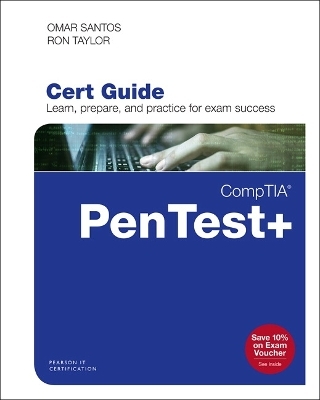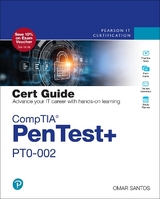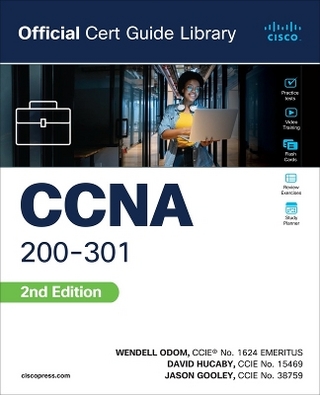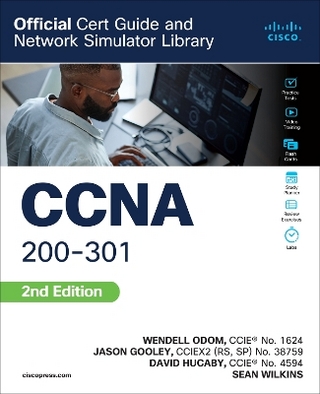
CompTIA PenTest+ PT0-001 Cert Guide
Pearson IT Certification
978-0-7897-6035-7 (ISBN)
- Titel erscheint in neuer Auflage
- Artikel merken
Master CompTIA Pentest+ PT0-001 exam topics
Assess your knowledge with chapter-ending quizzes
Review key concepts with exam preparation tasks
Practice with realistic exam questions
Get practical guidance for next steps and more advanced certifications
CompTIA Pentest+ Cert Guide is a best-of-breed exam study guide. Best-selling author Omar Santos and leading IT security expert Ron Taylor share preparation hints and test-taking tips, helping you identify areas of weakness and improve both your conceptual knowledge and hands-on skills. Material is presented in a concise manner, focusing on increasing your understanding and retention of exam topics.
The book presents you with an organized test preparation routine through the use of proven series elements and techniques. Exam topic lists make referencing easy. Chapter-ending Exam Preparation Tasks help you drill on key concepts you must know thoroughly. Review questions help you assess your knowledge, and a final preparation chapter guides you through tools and resources to help you craft your final study plan.
The companion website contains the powerful Pearson Test Prep practice test software, complete with 340 exam-realistic questions. The assessment engine offers you a wealth of customization options and reporting features, laying out a complete assessment of your knowledge to help you focus your study where it is needed most.
Well regarded for its level of detail, assessment features, and challenging review questions and exercises, this study guide helps you master the concepts and techniques that will allow you to succeed on the exam the first time.
The CompTIA study guide helps you master all the topics on the Pentest+ exam, including:
Planning and scoping: Explain the importance of proper planning and scoping, understand key legal concepts, explore key aspects of compliance-based assessments
Information gathering and vulnerability identification: Understand passive and active reconnaissance, conduct appropriate information gathering and use open source intelligence (OSINT); perform vulnerability scans; analyze results; explain how to leverage gathered information in exploitation; understand weaknesses of specialized systems
Attacks and exploits: Compare and contrast social engineering attacks; exploit network-based, wireless, RF-based, application-based, and local host vulnerabilities; summarize physical security attacks; perform post-exploitation techniques
Penetration testing tools: Use numerous tools to perform reconnaissance, exploit vulnerabilities and perform post-exploitation activities; leverage the Bash shell, Python, Ruby, and PowerShell for basic scripting
Reporting and communication: Write reports containing effective findings and recommendations for mitigation; master best practices for reporting and communication; perform post-engagement activities such as cleanup of tools or shells
Omar Santos is a principal engineer in the Cisco Product Security Incident Response Team (PSIRT) within Cisco’s Security Research and Operations. He mentors and leads engineers and incident managers during the investigation and resolution of security vulnerabilities in all Cisco products, including cloud services. Omar has been working with information technology and cybersecurity since the mid-1990s. He has designed, implemented, and supported numerous secure networks for Fortune 100 and 500 companies and the U.S. government. Prior to his current role, he was a technical leader within the Worldwide Security Practice and the Cisco Technical Assistance Center (TAC), where he taught, led, and mentored many engineers within both organizations. Omar is an active member of the security community, where he leads several industrywide initiatives and standards bodies. His active role helps businesses, academic institutions, state and local law enforcement agencies, and other participants that are dedicated to increasing the security of the critical infrastructure. Omar often delivers technical presentations at many cybersecurity conferences. He is the author of more than 20 books and video courses. You can follow Omar on any of the following: Personal website: omarsantos.io and theartofhacking.org Twitter: @santosomar LinkedIn: https://www.linkedin.com/in/santosomar Ron Taylor has been in the information security field for almost 20 years, 10 of which were spent in consulting. In 2008, he joined the Cisco Global Certification Team as an SME in information assurance. In 2012, he moved into a position with the Security Research & Operations group, where his focus was mostly on penetration testing of Cisco products and services. He was also involved in developing and presenting security training to internal development and test teams globally. In addition, he provided consulting support to many product teams as an SME on product security testing. He then spent some time as a consulting systems engineer specializing in Cisco’s security product line. In his current role, he works in the Cisco Product Security Incident Response Team (PSIRT). He has held a number of industry certifications, including GPEN, GWEB, GCIA, GCIH, GWAPT, RHCE, CCSP, CCNA, CISSP, and MCSE. Ron is also a Cisco Security Blackbelt, SANS mentor, cofounder and president of the Raleigh BSides Security Conference, and an active member of the Packet Hacking Village team at Defcon. You can follow Ron on any of the following: Twitter: @Gu5G0rman LinkedIn: www.linkedin.com/in/-RonTaylor
Introduction xxiii
Chapter 1 Introduction to Ethical Hacking and Penetration Testing 3
“Do I Know This Already?” Quiz 3
Understanding Ethical Hacking and Penetration Testing 6
Understanding the Current Threat Landscape 7
Exploring Penetration Testing Methodologies 10
Building Your Own Lab 16
Requirements and Guidelines for Penetration Testing Labs 18
What Tools Should You Use in Your Lab? 18
What if You Break Something? 19
Review All Key Topics 20
Define Key Terms 20
Q&A 21
Chapter 2 Planning and Scoping a Penetration Testing Assessment 25
“Do I Know This Already?” Quiz 25
Explaining the Importance of the Planning and Preparation Phase 29
Understanding the Legal Concepts of Penetration Testing 41
Learning How to Scope a Penetration Testing Engagement Properly 44
Learning the Key Aspects of Compliance-Based Assessments 50
Review All Key Topics 58
Define Key Terms 59
Q&A 59
Chapter 3 Information Gathering and Vulnerability Identification 63
“Do I Know This Already?” Quiz 63
Understanding Information Gathering and Reconnaissance 67
Understanding the Art of Performing Vulnerability Scans 103
Understanding How to Analyze Vulnerability Scan Results 112
Review All Key Topics 116
Define Key Terms 117
Q&A 117
Chapter 4 Social Engineering Attacks 121
“Do I Know This Already?” Quiz 121
Understanding Social Engineering Attacks 125
Phishing 126
Pharming 126
Malvertising 127
Spear Phishing 128
SMS Phishing 134
Voice Phishing 135
Whaling 135
Elicitation, Interrogation, and Impersonation (Pretexting) 135
Social Engineering Motivation Techniques 137
Shoulder Surfing 137
USB Key Drop and Social Engineering 138
Review All Key Topics 138
Define Key Terms 139
Q&A 139
Chapter 5 Exploiting Wired and Wireless Networks 143
“Do I Know This Already?” Quiz 143
Exploiting Network-Based Vulnerabilities 148
Exploiting Wireless and RF-Based Attacks and Vulnerabilities 185
Review All Key Topics 200
Define Key Terms 202
Q&A 202
Chapter 6 Exploiting Application-Based Vulnerabilities 207
“Do I Know This Already?” Quiz 207
Overview of Web Applications for Security Professionals 213
How to Build Your Own Web Application Lab 224
Understanding Injection-Based Vulnerabilities 227
Exploiting Authentication-Based Vulnerabilities 242
Exploiting Authorization-Based Vulnerabilities 250
Understanding Cross-Site Scripting (XSS) Vulnerabilities 252
Understanding Cross-Site Request Forgery Attacks 260
Understanding Clickjacking 261
Exploiting Security Misconfigurations 262
Exploiting File Inclusion Vulnerabilities 264
Exploiting Insecure Code Practices 265
Review All Key Topics 271
Define Key Terms 272
Q&A 273
Chapter 7 Exploiting Local Host and Physical Security Vulnerabilities 277
“Do I Know This Already?” Quiz 277
Exploiting Local Host Vulnerabilities 281
Understanding Physical Security Attacks 326
Review All Key Topics 328
Define Key Terms 329
Q&A 329
Chapter 8 Performing Post-Exploitation Techniques 333
“Do I Know This Already?” Quiz 333
Maintaining Persistence After Compromising a System 337
Understanding How to Perform Lateral Movement 347
Understanding How to Cover Your Tracks and Clean Up Systems After a Penetration Testing Engagement 356
Review All Key Topics 357
Define Key Terms 358
Q&A 358
Chapter 9 Penetration Testing Tools 361
“Do I Know This Already?” Quiz 361
Understanding the Different Use Cases of Penetration Testing Tools and How to Analyze Their Output 365
Leveraging Bash, Python, Ruby, and PowerShell in Penetration Testing Engagements 460
Review All Key Topics 462
Define Key Terms 465
Q&A 465
Chapter 10 Understanding How to Finalize a Penetration Test 471
“Do I Know This Already?” Quiz 471
Explaining Post-Engagement Activities 474
Surveying Report Writing Best Practices 475
Understanding Report Handling and Communications Best Practices 499
Review All Key Topics 501
Define Key Terms 502
Q&A 502
Chapter 11 Final Preparation 505
Tools for Final Preparation 505
Suggested Plan for Final Review/Study 509
Summary 509
Appendix A Answers to the “Do I Know This Already?” Quizzes and
Online Elements:
Glossary of Key Terms
Appendix B Study Planner
TOC, 9780789760357
| Reihe/Serie | Certification Guide |
|---|---|
| Verlagsort | Upper Saddle River |
| Sprache | englisch |
| Maße | 194 x 234 mm |
| Gewicht | 1180 g |
| Themenwelt | Mathematik / Informatik ► Informatik ► Netzwerke |
| Informatik ► Weitere Themen ► Zertifizierung | |
| ISBN-10 | 0-7897-6035-5 / 0789760355 |
| ISBN-13 | 978-0-7897-6035-7 / 9780789760357 |
| Zustand | Neuware |
| Haben Sie eine Frage zum Produkt? |
aus dem Bereich



